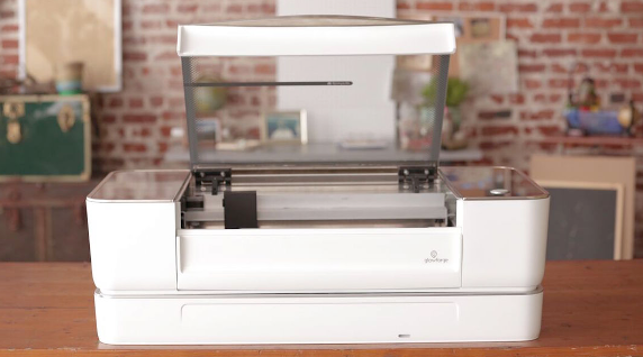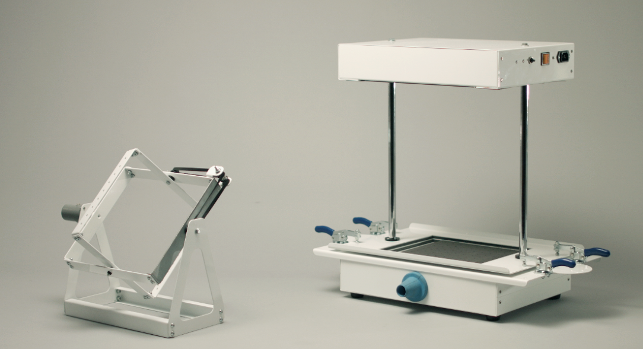What’s with the current obsession with shrinking every technology to fit on the desktop, asks Al Dean – and is it really such a bright idea to attempt high-temperature industrial processes in confined spaces?

Glowforge’s new low-cost laser cutter the Form 2 could be an essential tool for the prototyping workshop
In recent weeks, we’ve seen some very interesting moves at the desktop end of the ‘equipment for making stuff’ industry.
As you can read in this issue’s news pages, Formlabs has updated its range of machines with the Form2, which brings to market a more closed-loop, production-ready solution, with more automation, less manual intervention and less fiddling with resins.
We’ve also seen Glowforge start to take orders for its sub-$2,000 laser cutter that looks to make the hardware cheaper, but also focuses on making the user experience more efficient.
And then there’s London based startup Mayku, which is developing a range of products ideal for the small workshop or back office, covering vac forming and rotomoulding (have a gander at mayku.me to see what they’re up to).
If you’ve an interest in manufacturing your own prototypes or short-run products, there’s never been a better time to have some budget and space for a new machine.
At the same time, we’ve also seen a slew of announcements around the sintering market and most recently, we came across a strange news report regarding the head of the Department of Materials Science at MIT, wandering around with the VC circuit, trying
to find funding for a mysterious machine.
To quote the story on betaboston.com, “The startup, Desktop Metal, is so new that it doesn’t yet have a website or a working prototype. But the objective is to build a 3D printer that can crank out parts in a range of high-performance metals (think aluminum and titanium) and be quiet and clean enough to sit on a designer’s desktop.”
This got us discussing it in the office: what is this strange obsession with taking all of the technology available and recreating it at the desktop level?
When it comes to extruding and placing filament at 270 degrees celsius or flashing photo-curable resins with light from a projector – well, that’s one thing and it’s relatively risk-free.
But is it really appropriate to take what is, essentially, a highly dangerous industrial process associated with manufacturing parts in a layer-based manner and move that onto the desktop?
Consider for one minute what we’re talking about here (and yes, I’m aware I’m probably quoting from a source that’s not particularly savvy with the process): building parts in titanium or aluminium on the desktop.
There’s a couple of ways you could make this happen. You could machine it. Yes, that could, theoretically, be done on the desktop.
There is a wide range of desktop CNCs out there now. Would they easily and safely cut those types of metals? Probably. But you’d need to factor in coolant and swarf disposal.
CNC is a messy business. And it requires rigidity to do it accurately. That’s not something appropriate for the desktop.
Roland has had ‘office-friendly-ish’ CNCs for decades. The folks at Muncaster Technologies are working on an office-based CNC machine that will give you what you need, but a makerbot with a cutter it certainly won’t be.
Other methods are more in line with sintering machines or laser cladding. Both are highly industrial process. Laser cladding involves building up a near-net shape, using a robotically or CNC-driven welding gun. Sintering is fusing together powdered material (using various methods) to nearmelt the powder into a solid.
The former means you’d have a contained TIG welder on your desk. The latter means you’ve got powdered metal floating around the gaff. Both are dangerous — the latter is particularly volatile and, in the case of titanium, has a melt temp around the 1,600 degree-plus mark but, significantly, a flash point that’s much, much lower.

Mayku’s range of products includes a pretty nifty vac former and rotomoulding device
Even if the technicalities are overcome (metals sintering machines are built like tanks – or more accurately, bombs – because of what they have to achieve), you’ll need an inert gas feed, stainless steel flasks to contain your powder, an industrial vacuum that looks more like a minor repairs droid from the Death Star than a Dyson, a bandsaw to remove your parts from the build plate.
That’s not really going to fly with the health and safety folks, is it?
That said, significant hurdles have been crossed before. We might not have Mr Fusion in the back of a Delorean just yet, but science and invention has thrown up solutions to problems previously thought unsolvable.
With the team that Desktop Metal has assembled (including signing up one of the key early investors in Onshape, Markforged and others as CEO), the company’s clearly got something coming that we’re not foreseeing.
But why the push for the desktop? I think ulitmately, it comes down to hype and PR.
If you claim to enable folks to build on the desktop, you get more attention, because to some, at least, the desktop is more sexy than the workshop.
After that, reality sets in: what we’re actually talking about could be some messy room, out the back of the unit, where you can actually get to work.
Will we have a desktop unit soon that lets us build prototypes in metals and doesn’t cost 100K? I hope so – because it sounds amazing – but I have my reservations about whether we should be working that way in the first place. 
What’s with the current obsession with shrinking every technology to fit on the desktop?
Default






